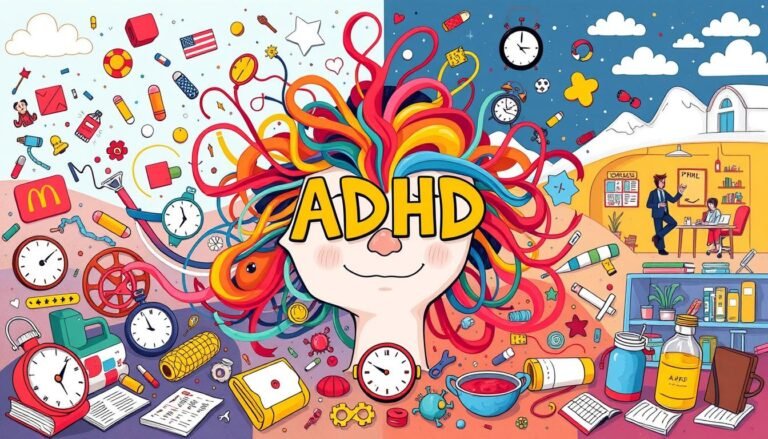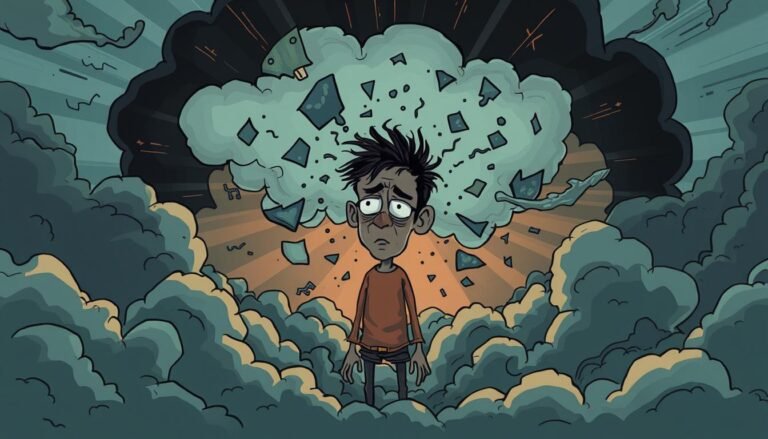Overcoming Social Anxiety Disorder: Your Guide
Do you avoid social situations or feel scared when meeting new people? You’re not alone. Social anxiety disorder affects millions, making everyday interactions tough. This guide will help you understand and overcome social phobia, building your confidence.
Social anxiety disorder is more than shyness. It’s a constant fear of being judged or embarrassed in public. Symptoms include blushing, sweating, racing hearts, and trembling. But there’s hope. With the right strategies, you can manage your anxiety and enjoy social life again.
In this guide, we’ll look at the causes, impacts, and treatments for social anxiety disorder. Whether you struggle with public speaking or eating out, we’ve got you covered. Let’s start this journey together, turning fear into freedom, step by step.
Understanding Social Anxiety Disorder
Social anxiety disorder is a complex mental health issue affecting millions in the U.S. It’s more than just shyness, causing deep fear and discomfort in social situations. Let’s dive deeper to understand it better.
What is social anxiety disorder?
Social anxiety disorder, also known as social phobia, is a condition marked by extreme fear of social interactions. It affects about 15 million American adults, making it the second most common anxiety disorder. People with this condition worry a lot about being judged or embarrassed in social settings.
Common symptoms and signs
Social anxiety symptoms can be emotional and physical. Emotionally, people may feel too self-conscious and worried about social events. Physical signs often include:
- Blushing
- Sweating
- Trembling
- Difficulty concentrating
- Rapid heartbeat
Differentiating social anxiety from shyness
While 90% of people feel shy at times, social anxiety disorder is more severe. It significantly impacts daily life, often leading to avoiding social situations. Unlike shyness, social anxiety can last for years without treatment. Only 5% of those affected seek help within the first year of symptoms, showing the need for more awareness and support.
“Social anxiety disorder usually emerges around age 13 and can be linked to a history of abuse, bullying, or teasing.”
Understanding social anxiety disorder is key for early intervention and effective treatment. By recognizing its symptoms and impact, we can create a more supportive environment for those affected by this challenging condition.
Causes and Risk Factors of Social Anxiety
Social anxiety comes from a mix of factors. Genetics play a big part, with studies showing a link to family history. Childhood experiences, like bullying, also play a role.
Risk factors for social anxiety include:
- Family history of anxiety disorders
- Traumatic social experiences
- Overprotective parenting styles
- Neurological differences in brain structure
Women are more likely to have social anxiety than men. It usually starts before age 20, often in the teens. People with less education and lower income also face higher risks.
| Factor | Impact on Social Anxiety |
|---|---|
| Genetic Predisposition | Increased likelihood of developing the disorder |
| Environmental Influences | Can trigger or exacerbate symptoms |
| Neurotransmitter Imbalances | May contribute to anxiety symptoms |
| Childhood Experiences | Can shape social anxiety development |
Knowing the causes and risk factors is key to treating social anxiety early. Healthcare professionals can use this knowledge to create effective treatments. This helps people deal with this tough condition.
The Impact of Social Anxiety on Daily Life
Social anxiety can affect many parts of a person’s life. It can impact personal relationships and work performance. Let’s look at how it affects daily life.
Personal Relationships and Social Interactions
Social anxiety can lead to problems in relationships. People might avoid social events or find it hard to connect deeply. They may feel judged or fear being rejected, making it tough to relax around others.
This can lead to feeling isolated and lonely.
Professional and Academic Performance
At work, social anxiety can hold people back. They might shy away from leadership roles or struggle to speak up in meetings. Students could find group projects or presentations hard.
This can slow down career and academic progress.
Overall Quality of Life
Social anxiety can really affect how well someone lives. Simple tasks like ordering food or making phone calls become hard. People miss out on fun experiences and chances to grow.
| Area of Life | Impact of Social Anxiety |
|---|---|
| Relationships | Difficulty forming connections, avoiding social events |
| Work | Reduced job performance, missed promotions |
| Education | Struggle with group work, lower grades |
| Daily Tasks | Challenges with simple interactions, increased stress |
It’s important to understand how social anxiety affects people. With the right support and treatment, symptoms can be managed. This can improve overall well-being.
Effective Strategies for Managing Social Anxiety Disorder
Social anxiety treatment offers hope for those struggling with this challenging condition. Let’s explore some proven strategies to help you overcome social fears and live a more fulfilling life.
Cognitive Behavioral Therapy (CBT)
CBT is a powerful tool in social anxiety treatment. This approach helps you identify and challenge negative thought patterns. By changing how you think about social situations, you can reduce anxiety and boost confidence.
Exposure Therapy and Gradual Desensitization
Exposure therapy involves facing feared situations step by step. This method helps you build confidence and reduce anxiety over time. Start small and work your way up to more challenging scenarios.
Relaxation Techniques and Mindfulness Practices
Relaxation techniques can help manage physical symptoms of anxiety. Try deep breathing exercises or progressive muscle relaxation. Mindfulness practices teach you to stay present, reducing worry about future social events.
Medication Options
In some cases, anxiety medication may be prescribed. Selective serotonin reuptake inhibitors (SSRIs) are often used to treat social anxiety disorder. Venlafaxine is another option that can be effective.
| Treatment Type | Effectiveness | Common Examples |
|---|---|---|
| CBT | High | Thought challenging, behavior modification |
| Exposure Therapy | High | Gradual social interaction practice |
| Relaxation Techniques | Moderate | Deep breathing, progressive muscle relaxation |
| Medication (SSRIs) | Moderate to High | Prozac, Zoloft, Paxil |
Remember, overcoming social anxiety takes time and practice. Combining these strategies can lead to significant improvements in your social life and overall well-being.
Conclusion
Many people face the challenge of overcoming social anxiety, with up to 13% of the population dealing with it. Thankfully, social phobia treatment has made great strides, offering hope to those in need. With various strategies for managing anxiety, recovery is achievable for most.
Social anxiety disorder often starts in childhood or early teens, with a mean onset age of 10 to 13. While women are slightly more affected, men should also seek help. It can significantly impact daily life, even affecting job performance and increasing unemployment rates.
Though managing social anxiety may seem tough, effective treatments are available. Options include cognitive-behavioral therapy and exposure techniques. With dedication and support, it’s possible to lessen symptoms and enhance your life. Don’t let social anxiety hold you back – start your journey to confidence today.
Source Links
- Social Anxiety Disorder – HelpGuide.org
- Social anxiety self-help guide
- Social anxiety (social phobia)
- Social Anxiety Disorder | Anxiety and Depression Association of America, ADAA
- What Is Social Anxiety Disorder or Social Phobia?
- Module 1 – Understanding Social Anxiety
- Social Anxiety Disorder: Symptoms, Tests, Causes & Treatments
- Social anxiety disorder: A review of environmental risk factors
- Social Anxiety Disorder: Causes, Symptoms, and Diagnosis
- Social Anxiety Disorder: More Than Just Shyness
- What is it like to live with Social Anxiety?
- Social anxiety disorder (social phobia) – Symptoms and causes
- Social anxiety disorder (social phobia) – Diagnosis and treatment
- The Best Self-Help Strategies for Social Anxiety Disorder
- Effective Coping Skills for Social Anxiety Disorder
- Social Anxiety Disorder: More Than Just a Little Shyness
- SOCIAL ANXIETY DISORDER – Social Anxiety Disorder
- Social Anxiety Disorder (Social Phobia)- Causes, Symptoms and Treatment








